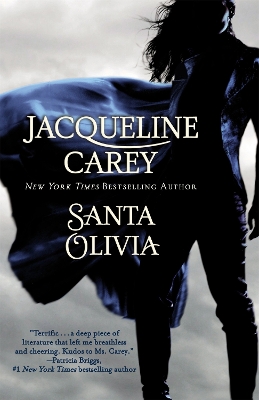Santa Olivia was nothing like I thought it was going to be. It was better! I wasn’t sure about it toward the middle, which is where the story changes direction, but the fact that I didn’t want to put it down speaks volumes. It’s set in the near future, in a government run town, after a deadly flu swept through the country. A wall was built around Santa Olivia to keep people from crossing the Mexican border, but to also keep the soon-forgotten citizen in. At least until Loup Garron is born.
Santa Olivia is genre-bending and has crossover appeal. It’s shelved as an Adult Dystopian and I can definitely see that. It’s certainly set in a not great future, and the content is quite mature. However, I would still high recommend it to fans of YA and even NA. The story follows Loup from conception (we also get a few chapters of her mother’s life before she became pregnant) up until she’s eighteen, with the bulk of the book covering her from ages 14-18. I personally would consider it NA based on Loup’s age and the content. Whatever you categorize it as, it’s good, and I recommend it.
I was immediately hooked into this world. I found it incredibly believable, and I must be in government conspiracy mood at the moment. It’s always the government! Loup’s father was kidnapped from Haiti as a child, along with other boys, and experimented on. What results is a super-human, and of course, Loup inherits the qualities that make him stand out. Unfortunately, he didn’t get to raise her, so she’s struggled to stay under the radar. However, all of that changes when she decides to pose as the town’s patron saint to right some wrongs. I wish there had been more of this vigilante justice! It was so fun, but alas, Loup had to look at the bigger picture.
About halfway through, Santa Olivia switches to a more revenge focused plot. I am all for revenge! But I wasn’t sure how I felt about boxing. Loup’s older brother was a boxer and died in the ring, so she wants to fight the man who took him down. Obviously, the man is a superhuman like her. I generally don’t care about boxing, but I was cheering for Loup during her training! I wanted to know if she could beat a man who’s bigger, stronger, and faster than her even with her own super abilities.
There’s also a sweet and steamy romance between Loup and one of the other orphan girls. I just want to squish them! There is sex, but it’s more fade to black and generalizations than anything graphic. They are underage, so that is more appropriate. And it’s another reason why I think this has appeal to all ages. There’s adult situations, but nothing gets overly graphic. There is some language, but whatever.
In the end, I seriously enjoyed Santa Olivia. I read it straight through with barely any breaks. The ending could stand alone as it is, but there’s sequel and I definitely needed more!
